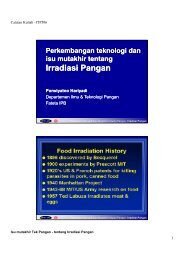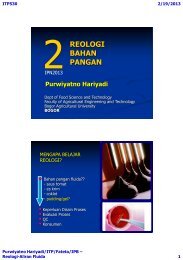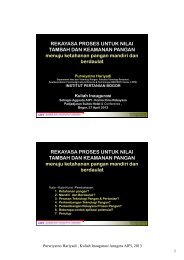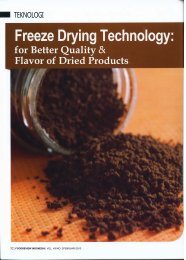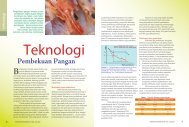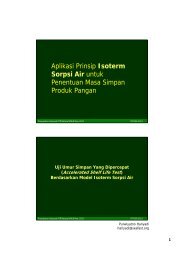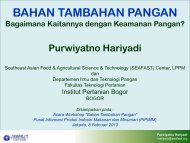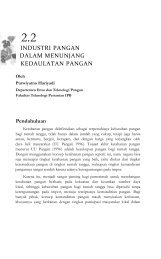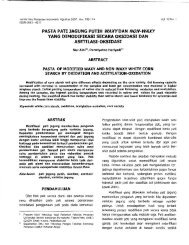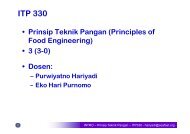Purwiyatno Hariyadi ITP530
Purwiyatno Hariyadi ITP530
Purwiyatno Hariyadi ITP530
You also want an ePaper? Increase the reach of your titles
YUMPU automatically turns print PDFs into web optimized ePapers that Google loves.
IPN-Dept ITP/IPB07/06/2011Trend ofAlternative FoodProcessing Technologies(based on IFT’s Report)<strong>Purwiyatno</strong> <strong>Hariyadi</strong><strong>ITP530</strong><strong>Purwiyatno</strong> <strong>Hariyadi</strong>/<strong>ITP530</strong><strong>Purwiyatno</strong> <strong>Hariyadi</strong>/<strong>ITP530</strong><strong>Purwiyatno</strong> <strong>Hariyadi</strong>/I<strong>ITP530</strong>- 20111
IPN-Dept ITP/IPB07/06/2011<strong>Purwiyatno</strong> <strong>Hariyadi</strong>/<strong>ITP530</strong>Alternative Food Processing Technologies :• Microwave and Radio Frequency• Ohmic and Inductive HeatingHigh Pressure Processing• Pulsed Electric Field• High Voltage Arc Discharge• Pulsed Light• Oscillating Magnetic Fields• Ultraviolet Light• Ultrasound• X-Rays<strong>Purwiyatno</strong> <strong>Hariyadi</strong>/<strong>ITP530</strong><strong>Purwiyatno</strong> <strong>Hariyadi</strong>/I<strong>ITP530</strong>- 20112
IPN-Dept ITP/IPB07/06/2011<strong>Purwiyatno</strong> <strong>Hariyadi</strong>/<strong>ITP530</strong><strong>Purwiyatno</strong> <strong>Hariyadi</strong>/<strong>ITP530</strong><strong>Purwiyatno</strong> <strong>Hariyadi</strong>/I<strong>ITP530</strong>- 20113
IPN-Dept ITP/IPB07/06/2011<strong>Purwiyatno</strong> <strong>Hariyadi</strong>/<strong>ITP530</strong>PENGGUNAAN GEL MIKRO (MICROWAVE/MW)UNTUK KEPERLUAN INDUSTRI :Gelombang mikroBerdekatan danTumpang tindihDengan kisaranGelombang radioBerpeluangmenggangguproseskomunikasiPenggunaan MWperlu diaturoleh badanyang berwenang,Mis.Di AS : Federal Communication Commissionmemperbolehkan pemakaian 4 frekuensi MW :22150, 5800, 2450 dan 915 MHzPaling banyak : 915 dan 2450 MHzInggris : 915 dan 2450 MHzJerman : 27,12; 433,92 dan 2450 MHzEropa Timur: 2375 MHz<strong>Purwiyatno</strong> <strong>Hariyadi</strong>/<strong>ITP530</strong><strong>Purwiyatno</strong> <strong>Hariyadi</strong>/I<strong>ITP530</strong>- 20114
IPN-Dept ITP/IPB07/06/2011PEMANASAN DIELEKTRIK (& GEL MIKRO) dipantulkan oleh metal diserap (diubah menjadi panas) oleh dielektrik : internal heating(Molecular friction).Generator(Oscilator)Bahanpangan+/-+/-δ+Hδ+HOδ-Oδ-++Hδ+δ+H“Perub.Orientasipolarisasi”Ionicdisplacement<strong>Purwiyatno</strong> <strong>Hariyadi</strong>/<strong>ITP530</strong>ListrikKonversi EnergiPanasP = 2π(ε( ε’) tan δE 2 o )( ) fP = 5.56x10 -13 ( ε’) tan δE 2 fP = jumlah panas yang diproduksi per satuan volume [=] W/m 3ε o = permitivity of free spaceε’ = konstanta dielektrik(sifat fisik bahan yang berhubungandengan polaritas atau Σ dipole)δ = loss angleE = kekuatan medan listrik [=] volts/mf = frekuensi (hz, s -1 )ε’ tan δ = ε’’ = loss factor<strong>Purwiyatno</strong> <strong>Hariyadi</strong>/<strong>ITP530</strong><strong>Purwiyatno</strong> <strong>Hariyadi</strong>/I<strong>ITP530</strong>- 20115
IPN-Dept ITP/IPB07/06/2011LOSS FACTOR∈ε” = f (SUHU, FREKUENSI)3530252015105CookedcarrotsH 2 O0-20 0 20 40 60SUHU ( o C)2MashedPotatoes160 450 MHz140120100806040900 MHz20 2700 MHz0-20 20 40 60SUHU ( o C)<strong>Purwiyatno</strong> <strong>Hariyadi</strong>/<strong>ITP530</strong>DAYA PENETRASI GEL MIKRO = dd =λo2π ε' tanδλ o = panjang gelombangKedalaman penetrasi, d[=] cmKadar air ε’ 915 MHz 2450 MHztinggi 15 8,4 3,1sedang 4 11,7 4,4rendah 1,5 22,1 8,2<strong>Purwiyatno</strong> <strong>Hariyadi</strong>/<strong>ITP530</strong><strong>Purwiyatno</strong> <strong>Hariyadi</strong>/I<strong>ITP530</strong>- 20116
IPN-Dept ITP/IPB07/06/2011PENINGKATAN SUHU DALAM PRODUKJumlah panas yang diperlukanuntuk meningkatkan suhu produk sebesar ΔTQ = mc ΔTQ = ρVcΔT atauΔT= Q/ρVcdimana V = volumeJumlah panas yang diproduksi oleh pemanasan gel mikro :Q = PVΔtQ = (5.56 x 10 -13 ε”E 2 f)VΔtJadi,ε”ΔT = 5.56 x 10 -13 cE2 f Δtρcuntuk pemanasan gel mikro yang sama,ΔT = ≈ ε” = f (Komponen bahan pangan)ρchomogenitas pemanasan = homogenitas bahan pangan<strong>Purwiyatno</strong> <strong>Hariyadi</strong>/<strong>ITP530</strong>Konfigurasi sistem sterilisasi/pasteurisasi dgn pemanasandielektrik dan gelombang mikroWaveguideMW GeneratorTreatmentChamberConveyorbeltMW generator (magnetron) : merubah energi listrik menjadi gel. MikroWaveguide : memfocuskan pancaran m.w (terowongan dari tabung Al)Treatment chamber: ruang tertutup/terlindung oleh logam<strong>Purwiyatno</strong> <strong>Hariyadi</strong>/<strong>ITP530</strong><strong>Purwiyatno</strong> <strong>Hariyadi</strong>/I<strong>ITP530</strong>- 20117
IPN-Dept ITP/IPB07/06/2011KARAKTERISTIK PEMANASAN GEL MIKRO• Memanaskan daerah yang mengandung air• Pemanasan berlangsung cepat• Tidak menyebabkan “gosong”pada permukaan• Mudah/PraktisAPLIKASI SPESIFIK PEMANASAN GEL. MIKRO :• Cocok untuk mengeringkan bahan setengah keringContoh : Pasta- waktu pengeringan turun dari 8 jam menjadi 90 menit- jumlah bakteri 15 kali lebih kecil- tidak mengalami case hardening Biji-bijian : terutama untuk Benih- meningkatkan laju germinasi Mengeringkan bagian dalam(tanpa overcooked dipermukaan)<strong>Purwiyatno</strong> <strong>Hariyadi</strong>/<strong>ITP530</strong>APLIKASI PEMANASAN GEL. MIKRO (UMUM):•Rumah tangga : microwave oven•Komersial4Pemanasan tanpa merubah sifat-sifat dasar produk :thawing & defrosing (tempering) i 4Pemanasan dengan merubah sifat-sifat dasar produk :Pengembangan adonan & pemangganganPemblansiran buah/sayuran : inativasi enzimPemasakan (cooking)Roasting (untuk kacang-kacangan)4Pengeringan : Dehidrasi pada tekanan normalDehidrasi pada tekanan vakum4Inaktivasi Mikroba :Sterilisasi & Pasteurisasi (kurang sukses ! :masih dalam penelitian!)<strong>Purwiyatno</strong> <strong>Hariyadi</strong>/<strong>ITP530</strong><strong>Purwiyatno</strong> <strong>Hariyadi</strong>/I<strong>ITP530</strong>- 20118
IPN-Dept ITP/IPB07/06/2011APLIKASI PEMANASAN GEL. MIKRO PADA PROSESPEMANGGANGAN Utama : ~ membantu proses pengeringan lanjut Proses pemanggangan dimulai dengan oven tradisional (mengg.udara panas) :Efektif untuk produk dengan kadar air tinggiDengan semakin menurunnya kadar air :efektifitas oven menuruncase hardening?!Pengeringan/pemanggangan selanjutnya :oven gel. Mikromengeringkan bag dalam (tanpa “overcooked” dipermukaan)<strong>Purwiyatno</strong> <strong>Hariyadi</strong>/<strong>ITP530</strong>APLIKASI PEMANASAN GEL. MIKRO PADA PROSESTHAWING :☺ Konduktivitas panas air < konduktivitas panas esProses pencairan : menurunkan proses pindah panas☺ Loss factor air > loss factor esProses pencairan : menaikan kadar air dan loss factor>>mempercepat p proses pemanasan☺ Problem : Pada bahan baku yang ukuran besar- proses pencairan tidak seragam- mengakibatkan overcooked pada bagian ttt<strong>Purwiyatno</strong> <strong>Hariyadi</strong>/<strong>ITP530</strong><strong>Purwiyatno</strong> <strong>Hariyadi</strong>/I<strong>ITP530</strong>- 20119
IPN-Dept ITP/IPB07/06/2011APLIKASI PEMANASAN GEL. MIKRO PADA PROSESDEFROSTING : Menaikan suhu produk beku: -20 o C menjadi -3 o C Untuk daging dan mentega mempermudah penanganan (slicing) Minimum overcooked Cepat : .................... >daging dapat didefrost selama 10 menit(tradisional: beberapa hari pada cold room) Minimum perubahan phase Minimum drip loss (kehilangan karena penetesan) Mutu meningkat: lebih higienik, lebih cepat, dapat dilakukan didalam box (pengemas) Ruang yang diperlukan sedikit Ekonomis<strong>Purwiyatno</strong> <strong>Hariyadi</strong>/<strong>ITP530</strong>APLIKASI PEMANASAN GEL. MIKRO PADA PROSESDEHIDRASI :VS. PEMANASAN TRADISIONAL/UDARA PANAS : Pindah panas turun :thermal conductivity turun pada bahan pangan kering Semakin lama waktu pengeringan mutu sensori dan mutu giziturun Oksidasi tinggi : mengakibatkan warna dan vitamin menurun.Untuk produk dengan kadar pufa tinggi, terjadi ketengikan Case hardening : perubahan karakteristik permukaan>> keras, susah ditembus oleh panas/uapair (kualitas produk menurun)<strong>Purwiyatno</strong> <strong>Hariyadi</strong>/<strong>ITP530</strong><strong>Purwiyatno</strong> <strong>Hariyadi</strong>/I<strong>ITP530</strong>- 201110
IPN-Dept ITP/IPB07/06/2011APLIKASI PEMANASAN GEL. MIKRO PADA PROSESDEHIDRASI :VS. PEMANASAN GELOMBANG MIKRO :Memanaskan bahan dari dalam :Tidak ada masalah ttg konduktivitas panasTidak memanaskan udara : mrengurangi ksidasi rendahTidak terjadi case hardening(pindah massa/uap air.........> lancar)Umumnya dipakai untuk mengeringkan semi/partly dried foods,dimana gel. Mikro akan tetap memanaskan daerah yang masihbasah, tanpa mempengaruhi daerah/bagian yang sudah kering.Mahal<strong>Purwiyatno</strong> <strong>Hariyadi</strong>/<strong>ITP530</strong>APLIKASI PEMANASAN GEL. MIKRO : LAIN-LAINMasih dalam taraf penelitian:Blansir, Pasteurisasi, SterilisasiPENGARUH GELOMBANG MIKRO TERHADAP BAHAN PANGAN : tidak ada pengaruh langsung pada mikroorganisme waktu proses menurun retensi gizi lebih baik (prinsip HTST)<strong>Purwiyatno</strong> <strong>Hariyadi</strong>/<strong>ITP530</strong><strong>Purwiyatno</strong> <strong>Hariyadi</strong>/I<strong>ITP530</strong>- 201111
IPN-Dept ITP/IPB07/06/2011PEMANASAN OHMICelektrodaBAHANS PowerSupplyP = I 2 RP = I 2 k-1eI = k e EL -1P : laju jumlah panas yang diproduksiper satuan volume (W.m - 3 )E : kekuatan medan listrik (Volt cm - 1 )k e : konduktivitas listrik (ohm - 1 /m , S/m)I : densitas arus listrik (amps/m 2 )R : tahanan listrik (ohm - 1 )- kecepatan pemanasan tergantung pada nilai k e bahan pangan-k e bahan pangan =f(kadar air, garam ionik dan asam)-k e bahan pangan cair >> k e bahan padat- minyak dan lemak mempunyai nilai k e sangat rendah<strong>Purwiyatno</strong> <strong>Hariyadi</strong>/<strong>ITP530</strong>PERBANDINGAN ANTARA PEMANASAN GEL MIKRO DAN OHMICKriteriaPemanasanGel MikroPemanasanOhmicKonduktivitas listrik 0.25-4 0.005-1.2(siemen/m)Generasi Panas untukmedan listrik 20 V/m 1-1616 0.02-5(W/cm 3 )Kenaikan suhu 0.25-4*0.004-1.2*( o C/sec)* kenaikan suhu di permukaan kaleng pada proses pemanasanretort adalah sekitar 0.2 o C/sec<strong>Purwiyatno</strong> <strong>Hariyadi</strong>/<strong>ITP530</strong><strong>Purwiyatno</strong> <strong>Hariyadi</strong>/I<strong>ITP530</strong>- 201112
IPN-Dept ITP/IPB07/06/2011Arah perambatan panas, QQ(r)Pr=2r22Pr⎡⎛ r⎞⎤T − T = ⎢ −0 1 ⎜ ⎟ ⎥4k ⎢⎣⎝ R ⎠ ⎥⎦k = konduktivitas panasKenaikan suhu maksimumT −max T =oKenaikan suhu rata-rataT−T0 =PR4k2PR8k2<strong>Purwiyatno</strong> <strong>Hariyadi</strong>/<strong>ITP530</strong>Contoh :Sebuah bahan berbentuk silinder dengan diameter 2R dan panjangL. Berapa Δ voltase (E) yang perlu diberikan supaya terjadipeningkatan suhu di pusat bahan sebesar (T max -T 0 ) o C, dimana suhuawal = T 0 .2PRJawab :T −T=max 0Gunakan4k2 2persamaanI R keEpeningkatan suhuT −max T =0 , I =4k k LTEmaxJadi,− T⎛= 2⎜⎝0LR=⎞⎟⎠e2⎛ keE⎞⎜ ⎟ R⎝ L ⎠4k kkk Te0e2T(T02⎛ E R=⎜2⎝4Lmax− T )02⎞⎛ke⎞⎟⎜⎟ ⎠⎝ k⎠<strong>Purwiyatno</strong> <strong>Hariyadi</strong>/<strong>ITP530</strong><strong>Purwiyatno</strong> <strong>Hariyadi</strong>/I<strong>ITP530</strong>- 201113
IPN-Dept ITP/IPB07/06/2011Vs PEMANASAN OHMIC & GELOMBANG MIKRO Mirip dengan pemanasan gel. Mikro :Konversi enegi listrik menjadi energi panas Penetrasi panas/daya penetrasi : tidak terbatas Suhu dalam bahan pangan merata (∇T ≈ 0) Tidak perlu “pengadukan”Cocok untuk memanaskan bahan pangan cair dgn partikulat :sop dll.<strong>Purwiyatno</strong> <strong>Hariyadi</strong>/<strong>ITP530</strong><strong>Purwiyatno</strong> <strong>Hariyadi</strong>/<strong>ITP530</strong><strong>Purwiyatno</strong> <strong>Hariyadi</strong>/I<strong>ITP530</strong>- 201114
IPN-Dept ITP/IPB07/06/2011Nilai konduktivitas listrik beberapa bahanBahannilai k e (s/m)Air murni (25 o C) 5,7x10-6Asam sulfat (25 o C) 1kentang(19 o C) 0.037wortel (19 o C) 0,041kacang kapri (19 o C) 0.17daging sapi (19 o C) 0,42Larutan pati (5,5%, 5% 19 o C)+ garam 0.2% 0,34+ garam 0,55% 1,3+ garam 2% 4,3<strong>Purwiyatno</strong> <strong>Hariyadi</strong>/<strong>ITP530</strong><strong>Purwiyatno</strong> <strong>Hariyadi</strong>/<strong>ITP530</strong><strong>Purwiyatno</strong> <strong>Hariyadi</strong>/I<strong>ITP530</strong>- 201115
IPN-Dept ITP/IPB07/06/2011KONFIGURASI SISTEM PEMANAS OHMICElektroda 4Elektroda 3Elektroda 1 Elektroda 2Elektroda 2Elektroda 1<strong>Purwiyatno</strong> <strong>Hariyadi</strong>/<strong>ITP530</strong><strong>Purwiyatno</strong> <strong>Hariyadi</strong>/<strong>ITP530</strong><strong>Purwiyatno</strong> <strong>Hariyadi</strong>/I<strong>ITP530</strong>- 201116
IPN-Dept ITP/IPB07/06/2011<strong>Purwiyatno</strong> <strong>Hariyadi</strong>/<strong>ITP530</strong>(ULTRA) HIGHPRESSUREPROCESSING~HIGHHYDROSTATICPRESSURE<strong>Purwiyatno</strong> <strong>Hariyadi</strong>/<strong>ITP530</strong><strong>Purwiyatno</strong> <strong>Hariyadi</strong>/I<strong>ITP530</strong>- 201117
IPN-Dept ITP/IPB07/06/2011Historical Timeline1895 H. Royer uses high pressure to kill bacteria.1899 Bert H. Hite at the West Virginia AgriculturalExperimental Station examined pressure effects on milk,meat, fruits and vegetables.1914 P. W. Bridgman coagulated egg albumen under highpressure.1990 First commercial products like fruit juices, jams, fruittoppings and tenderized meats introduced in Japan.1995 Orange juice commercialized in France.1997 Market introduction of guacamole in the US and slicedcooked ham in Spain.1999 Oysters introduced in the US.2000 Range of salsas launched in the US market.<strong>Purwiyatno</strong> <strong>Hariyadi</strong>/<strong>ITP530</strong>High hydrostatic pressure• Foods "pasteurized" by HHP undergo pressures ofup to 80,000 psi at or near ambient temperatures(under 45°C).• Under these conditions, HHP is effective ininactivating most vegetative pathogens commonlyfound in the foods.• Commercially available HHP-processed products inEurope and Asia include juices, jams, jellies, meatand yogurts.• Consumers in this country can buy HPP-processedguacamole and oysters.<strong>Purwiyatno</strong> <strong>Hariyadi</strong>/<strong>ITP530</strong><strong>Purwiyatno</strong> <strong>Hariyadi</strong>/I<strong>ITP530</strong>- 201118
IPN-Dept ITP/IPB07/06/2011High hydrostatic pressure• There is significant commercial interest indevelopment of other products.• Food processed by HHP reportedly has betterretention of flavor, texture, color, and nutrients.• The processing cost is slightly higher (two to threecents per pound) than for conventional processes.<strong>Purwiyatno</strong> <strong>Hariyadi</strong>/<strong>ITP530</strong>How High ??Two elephants balanced ona piston with a cross sectionof a dime will create apressure of 400 MegaPascal (Mpa). This isapproximately 60,000pounds per square inch.<strong>Purwiyatno</strong> <strong>Hariyadi</strong>/<strong>ITP530</strong><strong>Purwiyatno</strong> <strong>Hariyadi</strong>/I<strong>ITP530</strong>- 201119
IPN-Dept ITP/IPB07/06/2011HHP processing• High Pressure can kill microorganisms byinterrupting with their cellular functionwithout the use of heat that can damage thetaste, texture, and nutritional value of thefood.<strong>Purwiyatno</strong> <strong>Hariyadi</strong>/<strong>ITP530</strong>HHP processing• The "mechanism" of high-pressure based bacteria kill is lowenergy and ddoes not promote the formation of new chemicalcompounds, "radiolytic" by-products, or free-radicals.• Vitamins, texture and flavor are basically unchanged.• For example, enzymes can remain active in high pressureproduced orange juice.<strong>Purwiyatno</strong> <strong>Hariyadi</strong>/<strong>ITP530</strong><strong>Purwiyatno</strong> <strong>Hariyadi</strong>/I<strong>ITP530</strong>- 201120
IPN-Dept ITP/IPB07/06/2011HHP system• This 35-liter high-pressurebatch unit from FlowInternational can process up to700 lbs. an hour and isdesigned for prepackagedproducts such as bottledjuices.• Units with capacities up to 300liters are available.• Food scientists are optimisticabout hydrostatic pressure'sability to extend shelf life andproduce safe food.<strong>Purwiyatno</strong> <strong>Hariyadi</strong>/<strong>ITP530</strong>HHP system<strong>Purwiyatno</strong> <strong>Hariyadi</strong>/<strong>ITP530</strong><strong>Purwiyatno</strong> <strong>Hariyadi</strong>/I<strong>ITP530</strong>- 201121
IPN-Dept ITP/IPB07/06/2011Industrial High Pressure Food ProcessorsComplete systems are offered for bulk and in containerprocesses.<strong>Purwiyatno</strong> <strong>Hariyadi</strong>/<strong>ITP530</strong>Applications for High Pressure Processing arefound in the areas of...PreservationElimination or substantial reduction of spoilagemicroorganisms and enzymes for shelf lifeextension of refrigerated food products with superiorsensory quality, e.g. juices, jams, guacamole, salsa,meat & dairy products, seafood (commercialized)Acidified and low-acid shelf-stable products (underdevelopment)<strong>Purwiyatno</strong> <strong>Hariyadi</strong>/<strong>ITP530</strong><strong>Purwiyatno</strong> <strong>Hariyadi</strong>/I<strong>ITP530</strong>- 201122
IPN-Dept ITP/IPB07/06/2011Applications for High Pressure Processing arefound in the areas of...Food safetyElimination of pathogens: e.g. Listeria in meat products,Salmonella in eggs and poultry, Vibrio in oystersHypotheses for vegetative cell inactivation...- denaturation of proteins and enzymes- damage of DNA replication & transcription- solidification of membrane (phospho)lipids- breakage of bio-membranes (cell leakage)Spores are very resistant to pressure, but can be destroyedby combining pressure with elevated temperatures<strong>Purwiyatno</strong> <strong>Hariyadi</strong>/<strong>ITP530</strong>Applications for High Pressure Processing arefound in the areas of...• Juice tests have shown that foodpathogens such as salmonella andE.coli 0157:H7 can be effectivelydestroyed without changing thefruit juice's fresh, naturalcharacteristics.• A pressure exposure of 80,000 psifor 30 seconds can achieve a 3-5log reduction of all of thepathogens of concern in fresh juiceFruit Juice treated with HHP<strong>Purwiyatno</strong> <strong>Hariyadi</strong>/<strong>ITP530</strong><strong>Purwiyatno</strong> <strong>Hariyadi</strong>/I<strong>ITP530</strong>- 201123
IPN-Dept ITP/IPB07/06/2011Applications for High Pressure Processing arefound in the areas of...Oyster treated by HHP• Another example of food safety is thedestruction of Vibrio bacteria in rawoysters without destroying the raw feeland taste of the oyster.• A pressure of 200 to 300 MPa for 5 to 15minutes at 25C inactivated :· Vibrio parahaemolyticus ATCC 17803,· Vibrio vulnificus ATCC 27562,· Vibrio choleare ATCC 14035,· Vibrio choleare non-O:1 ATCC 14547,· Vibrio hollisae ATCC 33564· Vibrio mimicus ATCC 33653(from: "D. Berlin, D. Herson, D. Hicks, and D. Hoover;Applied and Environmental Microbiology, June 1999“)<strong>Purwiyatno</strong> <strong>Hariyadi</strong>/<strong>ITP530</strong>Applications for High Pressure Processing arefound in the areas of...Oyster treated by HHPPressure shucked raw clams.Pressure not only destroysthe vibrio family of bacteriathat can be found in shellfish,but also detaches the meatfrom the shell, saving laborand increasing gproductionefficiency.<strong>Purwiyatno</strong> <strong>Hariyadi</strong>/<strong>ITP530</strong><strong>Purwiyatno</strong> <strong>Hariyadi</strong>/I<strong>ITP530</strong>- 201124
IPN-Dept ITP/IPB07/06/2011Applications for High Pressure Processing arefound in the areas of...Styrofoam cup subjected to40,000 psi, fruit pack (withjuice) and sliced hamsubjected to 80,000 psi.<strong>Purwiyatno</strong> <strong>Hariyadi</strong>/<strong>ITP530</strong>Commercial High-Pressure Processed productsmarketed in Japan, Europe and the United StatesGuacamole & SalsasAvomex (Keller, TX)<strong>Purwiyatno</strong> <strong>Hariyadi</strong>/<strong>ITP530</strong><strong>Purwiyatno</strong> <strong>Hariyadi</strong>/I<strong>ITP530</strong>- 201125
IPN-Dept ITP/IPB07/06/2011Commercial High-Pressure Processed productsmarketed in Japan, Europe and the United States<strong>Purwiyatno</strong> <strong>Hariyadi</strong>/<strong>ITP530</strong>Commercial High-Pressure Processed productsmarketed in Japan, Europe and the United StatesJams & FruitToppings(Japan)<strong>Purwiyatno</strong> <strong>Hariyadi</strong>/<strong>ITP530</strong><strong>Purwiyatno</strong> <strong>Hariyadi</strong>/I<strong>ITP530</strong>- 201126
IPN-Dept ITP/IPB07/06/2011Examples of products commercialised in Europe and treated onHYPERBAR installations supplied by ACBULTI / PAMPRYL (Groupe PERNOD-RICARD) - France fresheysqueezed fruit juice Fresh pressedESPUNA - Spain – sliced cooked ham<strong>Purwiyatno</strong> <strong>Hariyadi</strong>/<strong>ITP530</strong>Applications for High Pressure Processing arefound in the areas of...TexturizationAs an alternative to heat processing texturization canbe accomplished by exposing protein (e.g. egg, whey,soy) and hydrocolloid (e.g. pectin, starch) solutionsto hydrostatic pressure. The resulting gels arecharacterized by uniquely different textures.<strong>Purwiyatno</strong> <strong>Hariyadi</strong>/<strong>ITP530</strong><strong>Purwiyatno</strong> <strong>Hariyadi</strong>/I<strong>ITP530</strong>- 201127
IPN-Dept ITP/IPB07/06/2011Applications for High Pressure Processing arefound in the areas of...Heat-sensitive compoundsHPP offers the unique potential to stabilize productswith heat-sensitive components (e.g. flavors,nutrients, biologically active compounds).BiotechnologySpecific enzymes can be activated under pressureleading to enhanced reaction rates and shorterprocess times.<strong>Purwiyatno</strong> <strong>Hariyadi</strong>/<strong>ITP530</strong>Thermally-assisted high-pressure lifts quality of shelf-stablefoodsProcess Variables for Optimum QualityTempera-turePressureProducts90°C 700 MPa Main meal entrees, meats, pasta dishes,most vegetables, sauces, cheese, soups,stews, flavored milk drinks80°C 830 MPa Whole potatoes, most vegetables70°C 1,000 MPa All potato products, all vegetables,seafood60°C 1,240 MPa Eggs, milkSource: Richard S. Meyer, PhD, Washington Farms, Inc.<strong>Purwiyatno</strong> <strong>Hariyadi</strong>/<strong>ITP530</strong><strong>Purwiyatno</strong> <strong>Hariyadi</strong>/I<strong>ITP530</strong>- 201128
IPN-Dept ITP/IPB07/06/2011Effect of pressure is very similar to the effectof temperature in thermal processesFigure. Change in inactivation of Zygosaccharomyces bailii with pressure. Notethat 345 MPa = 50,000 psi. (Enrique Palou, GRA, BSysE Dept., WSU)<strong>Purwiyatno</strong> <strong>Hariyadi</strong>/<strong>ITP530</strong>Thermally-assisted high-pressure lifts quality of shelf-stable foodsWhat's needed to commercialize UHP for sterilizing shelf-stableproducts?Two things must be done.First, develop the kinetic information necessary to file a petition with theFDA and USDA. To do that, we have to select the most heat andpressure-resistant strain of Clostridium botulinum. That work isunderway with the Dual Use Science & Technology (DUST) Program2000 headed by Dr. Patrick Dunne at the U. S. Army Natick SoldierCenter in Natick, Mass. Dual use refers to developing the technology forboth military and industrial applications.Second, we need commercial-size, inexpensive high-pressure vessels.Flow International Corp. (Kent, Wash.) is nearest to delivering that rightnow. They have a 215-liter vessel which is very close to all the criticalparameters for delivering a sterile product. They're leading with thetechnology, and just need to build a vessel to order.<strong>Purwiyatno</strong> <strong>Hariyadi</strong>/<strong>ITP530</strong><strong>Purwiyatno</strong> <strong>Hariyadi</strong>/I<strong>ITP530</strong>- 201129
IPN-Dept ITP/IPB07/06/2011Dosis Irradiasi• Dikendalikan oleh “the International Commission onRadiological Units” Rad• 1Rad= jumlah irradiasi yang menyebabkan 1 g bahan yangdiirradiasi akan menyerap energi sebesar 100 erg (1 Rad = 100erg/g)• Satuan umum “Grey“• 1 Grey = jumlah irradiasi yang menyebabkan 1 kg bahan yangdiirradiasi akan menyerap energi sebesar 1 joule;• 1,000 Grey = 1 kGy.• 100 Rad = 1 Gy<strong>Purwiyatno</strong> <strong>Hariyadi</strong>/<strong>ITP530</strong>Dosis Irradiasi<strong>Purwiyatno</strong> <strong>Hariyadi</strong>/<strong>ITP530</strong><strong>Purwiyatno</strong> <strong>Hariyadi</strong>/I<strong>ITP530</strong>- 201130
IPN-Dept ITP/IPB07/06/2011PENGARUH IRRADIASI PADA MIKROBAD 10,veg bacteriumD 10,yeastD 10 : dosis irradiasiyang menyebabkanpengurangan jumlahmikroba dengan faktor10 D 10 dose<strong>Purwiyatno</strong> <strong>Hariyadi</strong>/<strong>ITP530</strong>PENGARUH IRRADIASI PADAMIKROBAOrganism D value Resistance<strong>Purwiyatno</strong> <strong>Hariyadi</strong>/<strong>ITP530</strong><strong>Purwiyatno</strong> <strong>Hariyadi</strong>/I<strong>ITP530</strong>- 201131
IPN-Dept ITP/IPB07/06/2011PENGARUH IRRADIASI PADA MIKROBA_______________________________________________________organisme medium in D 10 (Rad)which irradiated_______________________________________________________Bacterial sporeC botulinum A36 buffer 0.33 10 6B53 buffer 0.33 10 6B57 canned chicken 0.37 10 6C. sprogenes 367 water 0.22 10 6Veg bacteriaSal typhimrium buffer 2.0 10 4egg yolk 8.0 10 4E coli buffer 9010 9.0 3YeastSacc cerevisiae saline 5.0 10 4MoldAsp niger saline 4.7 10 4<strong>Purwiyatno</strong> <strong>Hariyadi</strong>/<strong>ITP530</strong>PENGARUH IRRADIASI PADA MIKROBAModel inaktivasi mikroba oleh irradiasi bisa juga dinyatakan sbb :N=N 0e−DD ndimana,N = jumlah mo setelah iradiasi,N 0 = jumlah mo awal (sebelumiradiasi),D = Dosis radiasi yang diterima, danD = konstanta; t tgt t jenis mo dan kondisi i lingkunganD nKonstanta D n = dosis radiasi yang menyebabkan kematian mikrobasebanyak 63% populasi.<strong>Purwiyatno</strong> <strong>Hariyadi</strong>/<strong>ITP530</strong><strong>Purwiyatno</strong> <strong>Hariyadi</strong>/I<strong>ITP530</strong>- 201132
IPN-Dept ITP/IPB07/06/2011APLIKASI TEKNOLOGI IRRADIASIPADA BAHAN PANGANIrradiasi dosis rendah(sampai 1 kGy)(1 Gy = 1 Joule/Kg)MenghambatperkecambahanMenunda pematanganbuahDosis medium (1-10 kGy)Dosis tinggi ( > 10 kGy)Mengurangi risikopatogen danmeningkatkan masasimpan (keawetan)Strilisasi<strong>Purwiyatno</strong> <strong>Hariyadi</strong>/<strong>ITP530</strong>APLIKASI TEKNOLOGI IRRADIASIPADA BAHAN PANGAN<strong>Purwiyatno</strong> <strong>Hariyadi</strong>/<strong>ITP530</strong><strong>Purwiyatno</strong> <strong>Hariyadi</strong>/I<strong>ITP530</strong>- 201133



